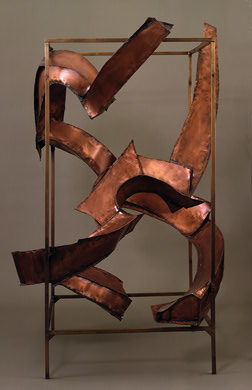Related Research Articles

Stephen Gilbert was a painter and sculptor from Scotland. He was one of the few British artists fully to embrace the avant-garde movement in Paris in the 1950s.
The year 1890 in art involved some significant events.

Benjamin Lauder Nicholson, OM was an English painter of abstract compositions, landscapes, and still-life. He was one of the leading promoters of abstract art in his country.

The Institute of Contemporary Arts (ICA) is an artistic and cultural centre on The Mall in London, just off Trafalgar Square. Located within Nash House, part of Carlton House Terrace, near the Duke of York Steps and Admiralty Arch, the ICA contains galleries, a theatre, two cinemas, a bookshop and a bar.

Paul Nash was a British surrealist painter and war artist, as well as a photographer, writer and designer of applied art. Nash was among the most important landscape artists of the first half of the twentieth century. He played a key role in the development of Modernism in English art.

Edward Alexander Wadsworth was a British artist initially associated with the Vorticism movement. In the First World War he was part of a team involved in the transfer of dazzle camouflage designs to ships for the Royal Navy. After the war his maritime landscapes and still-life compositions using tempera were infused with a surrealistic mood - although he never exhibited with the British surrealists. In the early thirties and in the early forties his work was mainly abstract. He made a significant contribution to the development of modern art in Britain in the inter-war years.
Events from the year 1933 in art.

John Samuel Tunnard was an English Modernist designer and painter. He was the cousin of landscape architect Christopher Tunnard.
Events from the year 1935 in art.

Frances Mary Hodgkins was a New Zealand painter chiefly of landscape and still life, and for a short period was a designer of textiles. She was born and raised in New Zealand, but spent most of her working life in England. She is considered one of New Zealand's most prestigious and influential painters, although it is the work from her life in Europe, rather than her home country, on which her reputation rests.
The Artists' International Association (AIA) was an organisation founded in London in 1933 out of discussion among Pearl Binder, Clifford Rowe, Misha Black, James Fitton, James Boswell, James Holland, Edward Ardizzone, Peter Laszlo Peri and Edith Simon.

Christopher David George "Kit" Nicholson was a British architect and designer. His principal buildings of the 1930s show strong influences of the Rationalist and International Modernist architectural movements.

Herbert Ferber was an American Abstract Expressionist, sculptor and painter, and a "driving force of the New York School."
Arthur Lett-Haines, known as Lett Haines, was a British painter and sculptor who experimented in many different media, though he generally characterised himself as "an English surrealist". He was part of a London artistic circle, which included D. H. Lawrence, the Sitwells and Wyndham Lewis, but for most of his life lived with the painter and gardener Cedric Morris in Cornwall, Paris and finally Suffolk.
Elizabeth Marion Rea was an English sculptor and educationalist.
The Seven and Five Society was an art group of seven painters and five sculptors created in 1919 and based in London.
Tristram Paul Hillier was an English surrealist painter. He was a member of the Unit One group led by Paul Nash.
The Geometry of Fear was an informal group or school of young British sculptors in the years after the Second World War. The term was coined by Herbert Read in 1952 in his description of the work of the eight British artists represented in the "New Aspects of British Sculpture" exhibition at the Biennale di Venezia of 1952.

The Mayor Gallery is an art gallery located in Cork Street, London, England. Since its foundation by Fred Mayor in partnership with Douglas Cooper in 1925, it has promoted modern and contemporary art. Since the early 1970s, under the new impulse given by James Mayor, Fred Mayor's son, the Gallery started to focus actively on the work of contemporary American artists from the Pop art movement but also Conceptual art and Abstract expressionism such as Eva Hesse, Roy Lichtenstein, Agnes Martin, Claes Oldenburg, Robert Rauschenberg, Robert Ryman, Cy Twombly and Andy Warhol. More recently, taking further its interest for Minimal art and Dada, the Gallery has been promoting artists of the international Zero (art) movement, including Heinz Mack, Otto Piene amongst others.
Ursula Ulalia Edgcumbe was a British sculptor and painter. As a sculptor she worked in stone, wood and bronze while, after switching to painting, many of her works depicted birds and groups of figures.
References
- ↑ Andrew Causey (2008). Unit One (act. 1933–1935). Oxford Dictionary of National Biography, online edition. Oxford: Oxford University Press. doi:10.1093/ref:odnb/96310.
- ↑ Herbert Read (editor) (1934) Unit One: the modern movement in English architecture, painting and sculpture. London: Cassell.
- ↑ [s.n.] (2003). Unit One. Grove Art Online. Oxford: Oxford University Press. doi:10.1093/gao/9781884446054.article.T087195. (subscription required).